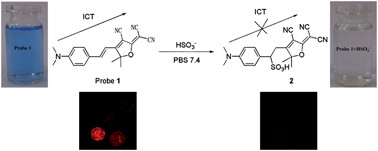A highly selective colorimetric and far-red fluorescent probe for imaging bisulfite in living cells
Abstract
The development of probes for specific bisulfite (HSO3−) detection is of great importance, due to its toxicity in the environment and important biological functions in living systems. In the present study, we developed a highly selective colorimetric and far-red fluorescent probe (1) for the determination of HSO3− in aqueous solution and living cells. The excellent properties of our proposed probe can be listed as follows. Firstly, probe 1 showed excellent selectivity for HSO3− over various other species including Cys, GSH, S2−, SO32−, and ROS, which might be ascribed to the introduction of a receptor of the electron-poor C![[double bond, length as m-dash]](https://www.rsc.org/images/entities/char_e001.gif) C double bond for HSO3−. Secondly, our proposed probe possesses the higher molar absorption coefficient, and it can serve as a sensitive “naked-eye” probe for HSO3−. So, probe 1 would provide a convenient and promising method for the visual detection of HSO3− and the toxic gaseous SO2 in the environment. Thirdly, probe 1 has a long-wavelength emission spectrum at 643 nm, and thus it possesses many superiorities over short-wavelength ones in bioimaging. Finally, probe 1 exhibited excellent cell permeability and low cytotoxicity for the successful detection of HSO3− in living RAW 264.7 macrophage cells, implying that this probe would be of great benefit to biological researchers for investigating the detailed biological and pharmacological functions of HSO3− in biological systems.
C double bond for HSO3−. Secondly, our proposed probe possesses the higher molar absorption coefficient, and it can serve as a sensitive “naked-eye” probe for HSO3−. So, probe 1 would provide a convenient and promising method for the visual detection of HSO3− and the toxic gaseous SO2 in the environment. Thirdly, probe 1 has a long-wavelength emission spectrum at 643 nm, and thus it possesses many superiorities over short-wavelength ones in bioimaging. Finally, probe 1 exhibited excellent cell permeability and low cytotoxicity for the successful detection of HSO3− in living RAW 264.7 macrophage cells, implying that this probe would be of great benefit to biological researchers for investigating the detailed biological and pharmacological functions of HSO3− in biological systems.


 Please wait while we load your content...
Please wait while we load your content...